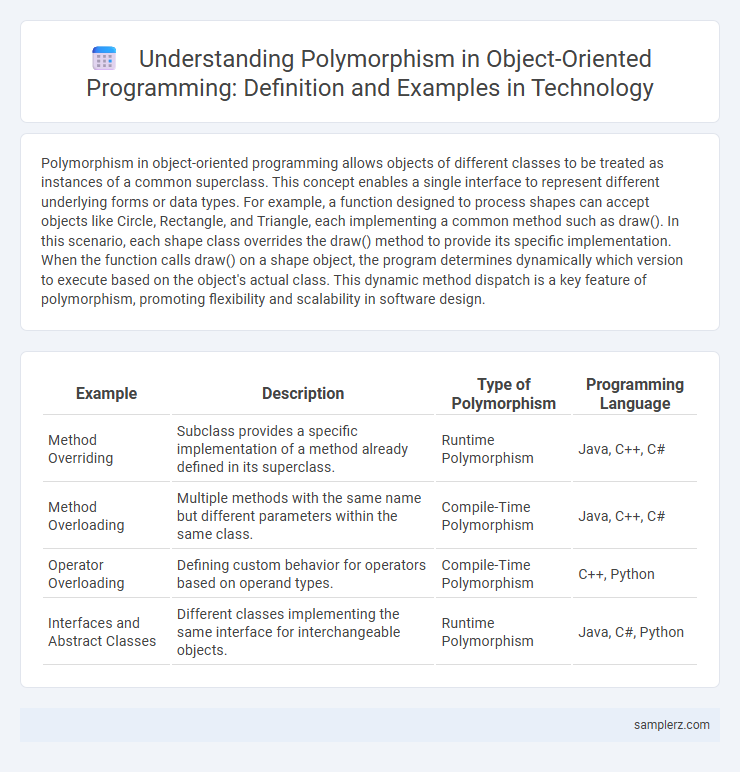Polymorphism in object-oriented programming allows objects of different classes to be treated as instances of a common superclass. This concept enables a single interface to represent different underlying forms or data types. For example, a function designed to process shapes can accept objects like Circle, Rectangle, and Triangle, each implementing a common method such as draw(). In this scenario, each shape class overrides the draw() method to provide its specific implementation. When the function calls draw() on a shape object, the program determines dynamically which version to execute based on the object's actual class. This dynamic method dispatch is a key feature of polymorphism, promoting flexibility and scalability in software design.
Table of Comparison
| Example | Description | Type of Polymorphism | Programming Language |
|---|---|---|---|
| Method Overriding | Subclass provides a specific implementation of a method already defined in its superclass. | Runtime Polymorphism | Java, C++, C# |
| Method Overloading | Multiple methods with the same name but different parameters within the same class. | Compile-Time Polymorphism | Java, C++, C# |
| Operator Overloading | Defining custom behavior for operators based on operand types. | Compile-Time Polymorphism | C++, Python |
| Interfaces and Abstract Classes | Different classes implementing the same interface for interchangeable objects. | Runtime Polymorphism | Java, C#, Python |
Introduction to Polymorphism in Object-Oriented Programming
Polymorphism in object-oriented programming allows objects of different classes to be treated as instances of a common superclass, enabling methods to operate on objects of various types through a single interface. For example, a base class "Shape" with a method "draw()" can be overridden by derived classes like "Circle," "Square," and "Triangle," each implementing "draw()" differently. This mechanism enhances code flexibility and scalability by supporting method overriding and compile-time or run-time polymorphism.
Real-World Analogies of Polymorphism
Polymorphism in object-oriented programming can be illustrated by real-world examples such as a smartphone acting as a camera, a GPS device, and a music player, each with different functionalities under the same interface. Another example is a remote control that operates various devices like a TV, air conditioner, and audio system, demonstrating method overriding and dynamic method dispatch. These analogies reflect how polymorphism allows objects to process data differently based on their specific class implementations while sharing a common interface.
Polymorphism through Method Overriding Example
Polymorphism in object-oriented programming allows a subclass to provide a specific implementation of a method already defined in its superclass, known as method overriding. For example, a base class "Animal" may have a method "makeSound()", while subclasses "Dog" and "Cat" override this method to output "bark" and "meow" respectively. This enables dynamic method dispatch, where the program calls the appropriate overridden method at runtime based on the object type.
Method Overloading as a Form of Polymorphism
Method overloading in object-oriented programming exemplifies polymorphism by allowing multiple methods with the same name to coexist within a class, differentiated by their parameter lists. This technique enhances code readability and flexibility by enabling the same method to perform varied operations based on input types or number of arguments. Common in languages like Java and C++, method overloading supports compile-time polymorphism, optimizing method invocation during program execution.
Interface-Based Polymorphism Use Cases
Interface-based polymorphism allows objects of different classes to be treated uniformly through shared interfaces, enabling flexible and extensible code design. Common use cases include implementing multiple service providers in payment processing systems, where classes like CreditCardPayment and PayPalPayment adhere to a PaymentInterface. This approach supports dynamic method invocation and simplifies adding new implementations without modifying existing codebase, enhancing maintainability and scalability.
Abstract Classes Demonstrating Polymorphism
Abstract classes in object-oriented programming enable polymorphism by providing a blueprint for derived classes to implement specific methods. For example, an abstract class `Shape` with an abstract method `draw()` allows subclasses like `Circle`, `Square`, and `Triangle` to define their own versions of `draw()`. This design ensures that objects of different shapes can be treated uniformly through a common interface while exhibiting distinct behaviors.
Polymorphism in Java: Code Example
Polymorphism in Java allows objects of different classes to be treated as instances of a common superclass, enabling dynamic method invocation. A classic example is method overriding, where a superclass defines a method, and subclasses provide specific implementations, such as a `Shape` class with a `draw()` method overridden by `Circle` and `Rectangle` subclasses. This polymorphic behavior is demonstrated when a `Shape` reference can point to any subclass object, and the appropriate `draw()` method is called at runtime, enhancing code flexibility and extensibility.
Implementing Polymorphism in Python
Implementing polymorphism in Python involves creating classes with methods that share the same name but behave differently based on the object's class. For example, defining a base class `Animal` with a method `speak()`, and then overriding this method in subclasses like `Dog` and `Cat` allows each subclass to provide its own specific behavior when `speak()` is called. This use of method overriding enables dynamic method resolution, a core concept of polymorphism in object-oriented programming.
Benefits of Using Polymorphism in Software Design
Polymorphism in object-oriented programming allows objects of different classes to be treated as instances of the same class through a common interface, enhancing code flexibility and scalability. This technique reduces code duplication by enabling a single function to operate on various data types, streamlining maintenance and future updates. Leveraging polymorphism fosters modular software design, improving readability and facilitating easier integration of new features without extensive refactoring.
Common Pitfalls and Best Practices with Polymorphism
Polymorphism in object-oriented programming allows methods to process objects of different types through a common interface, but common pitfalls include incorrect method overriding and excessive casting, which can lead to runtime errors and reduced code maintainability. Best practices involve using interfaces or abstract classes to define clear contracts, leveraging method overriding responsibly, and avoiding downcasting by designing with polymorphism in mind to improve code flexibility and scalability. Emphasizing unit testing for polymorphic behavior helps detect issues early and ensures reliable implementation.

example of polymorphism in object-oriented programming Infographic
 samplerz.com
samplerz.com